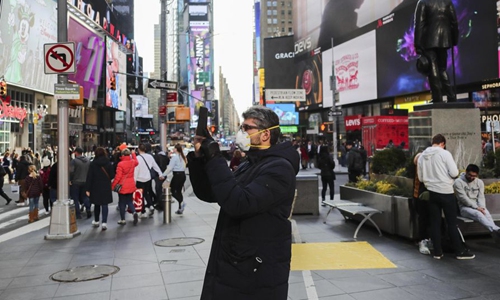HOME >> OPINION
New Yorkers' calm feels like the start of a horror film
By Rong Xiaoqing Source:Global Times Published: 2020/3/12 15:28:40

Tourists look around at Times Square in New York, the United States, on March 5. Photo: Xinhua
Recently, friends of mine in China have been sending me photos and videos via WeChat with the ultimate question of the internet era: "Are these true?" The images seem to show the US in the midst of an apocalypse, with aggressive shoppers rushing into supermarkets like a tsunami, and grabbing everything from toilet paper to potato chips like hungry wolves. The videos show quarrels, fistfights and near riots.While I understand the physical barrier of a vast ocean can make things look distorted. From here in New York City, I can report that the coronavirus hasn't turned the US into a living hell, at least not yet. Large supermarket chains like Costco and Walmart may have had a run on certain goods that have even sold out in some neighborhoods, but most supermarkets and grocery stores are operating normally with abundant supplies of most items.
Some of the images I've been sent actually show shoppers wrestling during the November "Black Friday" sales event.
On Sunday, a shop in my neighborhood in Queens, New York, was fully stocked with hand sanitizers, disinfectant wipes and gloves. There were just as many customers in front of that display as there were shoppers picking up painted eggs and chocolate bunnies for the upcoming Easter. There was no need to shove anyone.
This tranquil scene amidst an increasingly frantic world unsettled me. Some US authorities, and particularly those in the White House, have been reassuring people there isn't much to worry about. They don't seem to be fully grasping the situation let alone prepare for the worst. Some of their statements seem like they don't know what they are talking about.
In the past month or so, President Donald Trump told people that the virus would disappear when the weather gets warmer, defying the experience of tropical countries like Singapore that continue to scramble to deal with confirmed cases. Trump also declared that a vaccine could be ready in months, contradicting health experts who say it will be at least a year before one is available for mass inoculations.
Then there was the fiasco for faulty test kits provided by the US Centers for Disease Control and Prevention. Federal red tape meant the New York City, which has the highest population density in the country, was only able to start testing for the coronavirus on March 2, six weeks after the first infection was confirmed in the US.
At a press conference on Monday, New York government officials including the mayor and the health commissioner, tried to reassure citizens by stressing that 80 percent of infected people will only experience minor symptoms and will recover without medical help. The health commissioner said this means not everyone who shows symptoms would be tested, and they should just stay home and recover on their own.
Wearing face masks by everyone is also being discouraged. Officials say the masks are only useful in preventing sick people from infecting others, or preventing caregivers from contracting the disease. They maintain the general public don't need to wear masks as they won't prevent healthy people from being infected, even though the first line of defense for healthcare workers is a mask.
The glitches, inadequacy and the cavalier attitude displayed by US authorities are perplexing. The country has had plenty of time to prepare for the worst, after seeing how rapidly the virus spread in China and the Chinese government's massive measures that are proving so effective.
The US' sluggish start could be attributed to many factors, from ideological and cultural differences, to the artificial calm instilled by top leaders during an election year, and human nature that numbs us to problems from afar. This is not the time for psychoanalysis, because there is no time.
On the night of March 8, James Cai, a 32-year-old assistant at a clinic in New York's Chinatown who has tested positive, tweeted from his hospital bed that initially the hospital was treating him as if he has only suffering from the seasonal flu. He demanded the hospital follow Chinese protocols in his treatment, and transfer him to a better hospital.
The next day, my husband and I went to a Broadway show that we booked a long time ago. Of the more than 1,000 people crammed into the windowless theatre, we could see that we were the only two wearing face masks.
The show was an entertaining performance of Moulin Rouge, but for some moments it felt like I was stuck in some horror movie, as I imagined the virus ascending to the cheaper seats on the stuffy air we were breathing in the top balcony of the theater.
The author is a New York-based journalist and an Alicia Patterson Foundation fellow. rong_xiaoqing@hotmail.com
Posted in: COLUMNISTS,VIEWPOINT